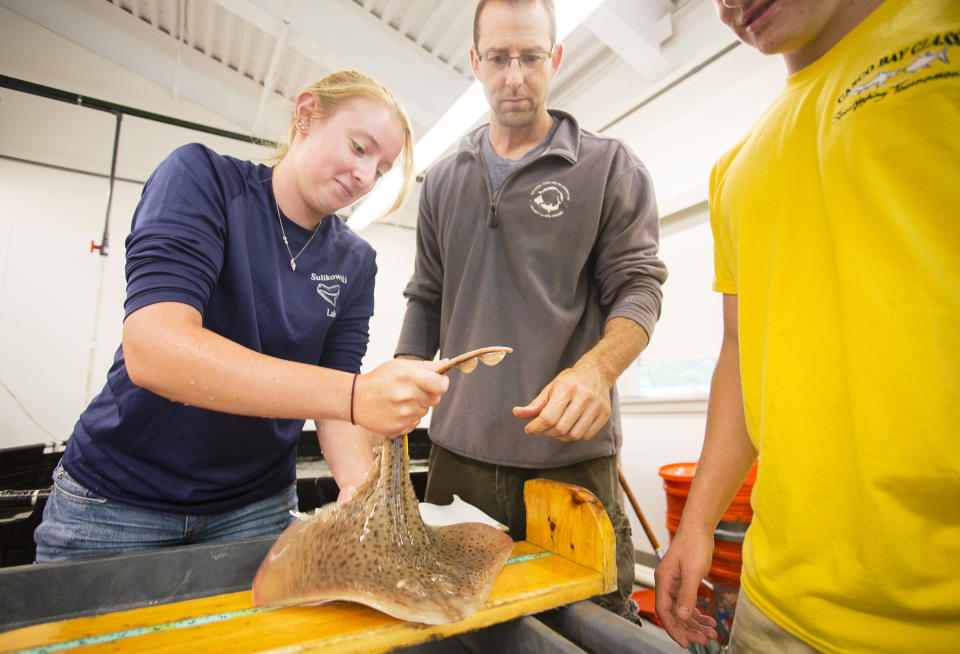After fatal great white shark attack in Maine, debate intensifies over culling seals

Two weeks ago Maine recorded its first fatal great white shark attack. Julie Dimperio Holowach, 63, of New York City, was splashing with her daughter approximately 20 yards off the coast of Bailey Island when a large shark, likely mistaking Holowach for a seal, struck her with such force that she was launched out of the water, witnesses said. She died at the scene.
The incident is not an anomaly. Beaches across the Northeast have closed repeatedly in recent days after great white sharks were spotted swimming close to shore, a worrying trend that has led some people to suggest that states thin the population of seals, the sharks’ primary source of food.
Local business owners and some Cape Cod, Mass., politicians have long called for culling the seal population there. Many worry that more shark sightings and beach closures could lead to a downturn in tourism, which is vital to the local economy.
All marine mammals are protected in the United States by the Marine Mammal Protection Act of 1972. Seal populations have multiplied exponentially in the years since the act, and marine scientists say levels are now so high that they are making a discernible difference in coastline shark activity since seals are among their favorite prey. Subsequent federal legislation also led to greater protections for sharks, experts say, leading to a far larger number of great whites. Still, not everyone thinks culling seals is the answer.
Greg Skomal, an internationally known shark expert and the program manager and senior scientist for Massachusetts’s Division of Marine Fisheries, began experimenting last month with sonar detection technology that he believes could become a useful early warning system for coastal swimmers.

Massachusetts, where “Jaws” was filmed, has grown weary of sharks after a series of attacks in recent years. Public horror at the Northeast’s shark resurgence crested after 26-year-old Arthur Medici was killed while bodysurfing in Wellfleet, Mass., in 2018 as throngs of beachgoers looked on. Boston Magazine dubbed the incident “the Shark Attack that Changed Cape Cod Forever.” Medici, a college student, died in the water before lifeguards could try to revive him.
Skomal said that with significantly more sharks, seals and people sharing the coastline, such attacks are bound to continue, making early detection vital. Sharks eat seals, and with a resurgent seal population drawing sharks closer to shore, more humans are encountering and being attacked by sharks.
While excited about the sonar technology his team is beta testing, Skomal worries it will give swimmers a false sense of security since a minority of the total shark population has been tagged with transmitters.
“There’s no silver bullet, no one solution that’s going to be 100 percent effective,” Skomal said in an interview with Yahoo News. “The only thing that’s going to be 100 percent effective is people don’t go in the water.”
Related: Experts talk about deadly shark attack in Maine
The Washington state-based sonar technology company Innovasea has leased six receivers for detecting high-pitched audio emitted by tagged sharks across Cape Cod. So far, Skomal has deployed two of these receivers in Wellfleet, where they have led to near daily beach closings. The technology is detecting a lot of sharks outfitted with acoustic transmitters swimming close to shore — even though Skomal has tagged only 200 sharks, an unknown percentage of the shark population in the area.
The shark audio detection equipment is expensive, so after a state-sponsored trial run, individual towns will have to decide whether they want to buy it, he said. Skomal noted that California State University, Long Beach has a few of the detection systems placed along the West Coast, where great white shark populations are also rebounding.
Skomal said the estimated 250,000 seals now swimming in the Northeastern U.S. are a 25-fold increase from a low in the 1980s, when seal populations were estimated at just 10,000 animals. But he said killing seals off, as some have suggested, is not a viable solution to the uptick in shark attacks.
“There weren’t sharks hunting close to shore [until recently] because the seals weren’t there, not in large numbers, so if you want to go back to that stage in time, think of the number of animals you’d have to remove,” Skomal said. “You’d be killing animals for the sake of killing them. Where would the bodies go? Who would do the killing?”
Skomal said seals have repopulated throughout the Northeast and are now on beaches across the East End of Long Island, N.Y.; Rhode Island; Cape Cod and the Gulf of Maine — where the shark population has also grown.

James Sulikowski, professor at Arizona State University’s School of Mathematical and Natural Sciences, said the degree to which seals have rebounded has been controversial.
“Many would say the population is recovered and that steps need to be taken to give relief to the ecosystem, much like Canada does with their culls,” Sulikowski said. “You can go to Canada and buy seal boots.” But while Sulikowski has tracked an increase in great white sharks in recent years, he said it would be a mistake to kill the seals they are drawn to hunt.
“As human beings we have to understand that we don’t belong in the water,” Sulikowski said. “We go there to enjoy it. So, if we start thinking of removing and changing ecosystems so that it fits our pleasure zones, then we really have some issues as a race.”
In Nassau County on Long Island, beach restrictions were in place last week due to multiple shark sightings close to shore. County Executive Laura Curran said Long Island has never experienced so many beach issues due to shark sightings. Helicopters have been deployed to scan the shallow coastal waters, and swimmers have been limited to going only waist- or, in some cases, ankle-deep.
“They’ve been getting quite close,” Curran said. “People are sort of laughing and saying, ‘Hey, just another day in 2020. Of course, there are more sharks than usual.’”
Sean Hayes, director of the Protected Species Branch of the Northeast Fisheries Science Center for the National Oceanic and Atmospheric Administration (NOAA), said that studies show a 10 to 15 percent annual population growth in the gray seal population throughout the Northeast region, including the East End of Long Island.
Researchers at NOAA are now studying how the larger marine ecosystem will be affected by the return of seals to coastal waters in the Northeast, Hayes said. When wolves were reintroduced to Yellowstone, he said, scientists were surprised to discover that the surrounding forest ecosystem improved.

Hayes said that even if seals were gone, there would still be more sharks in our waters — the shark population has also dramatically rebounded thanks to federal conservation efforts.
“The reality is the sharks have been recovering on their own with or without seals for quite some time, so there are also just a lot more sharks,” he said.
Hayes added that the waters off Cape Cod have long been the sharks’ domain. In the 1850s, Henry David Thoreau wrote often about the sharks and seals he saw off the Massachusetts coast. Hayes said historical accounts he has read suggest people used to swim in the water less because they feared shark attacks.
“We were able to build sailboats 200 years ago to sail around the planet, so we probably could have built a surfboard back then,” Hayes said. “But maybe we didn’t because it wasn’t a safe thing to do.”
Brian Carlstrom, the superintendent of Cape Cod National Seashore, agreed with that musing. Cape Cod beaches issue dire warnings about shark attacks, a decision Carlstrom said was made as incidents began increasing after an initial encounter in 2012, when a shark took a large bite out of a kayak.
Carlstrom urged those who lament the sudden omnipresence of the predators to think historically.
“We had recreation patterns develop with people in the water, surfing, recreating, splashing, swimming, in the absence of seals and sharks,” he said. “Now they’re back. They’ve returned to the ecosystem. ... Cape Cod has white sharks. It’s part of the natural environment. It’s their home.”
_____
Read more from Yahoo News:


